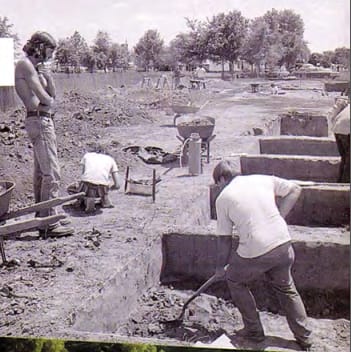Read the passage and answer questions 1-6.
|
| The Reading passage hos six paragraphs, A-F. Choose the correct heading for each paragraph from the list of headings below. Write the correct number, i-viii. |
|
Paragraph A
Paragraph B
Paragraph C
Paragraph D
Paragraph E
Paragraph F
|
|
List of headings
i. The benefits of collaboration
ii. A forerunner of the modern metropolis
iii. A period of intense activity and plans completed
iv. A clear contrast between then and now
v. The rise and mysterious decline of Cahokia
vi. An archaeological theory to explain Cahokia's development
vii. The light and dark of archaeological finds
viii. A city completely unlike any of its contemporaries
|
CAHOKIA - ANCESTOR OF TODAY'S CAPITAL CITIES
|

A thousand years ago the Mississippians, a diverse group of Native Americans who lived in the area which is today known as the southeastern United States, took a small viHage on the Mississippi River and turned it into one of the world's first great urban centres. Cahokia, as it has been called by archaeologists, became as large as London was in the 11th century, and some would argue that it was just as forward-looking and prosperous as its European equivalents. Sophisticated, cosmopolitan and ahead of its time, Cahokia was at the heart of ancient society in North America; an ancestor of today's capital cities.
|
|
In one respect in particular, Cahokia was quite unusual compared to other cities around at the same time. Archaeologists working on the site have found enough evidence over the past fifty years to conclude that, at a certain time, around 35% of the population were not from Cahokia at all; it seems that many of the tribes that lived all along the Mississippi River at some point began to relocate to Cahokia. These researchers have been unable to find more than a handful of other examples of such relocation of tribes, but they do know that something about Cahokia attracted thousands of people to this regional centre. And that, they postulated, appears to have been thanks to a smalt group of planners who one day decided to redesign the entire village.
|
|
After the redesigns of the village were put in place, the Native Americans at Cahokia worked with tireless determination to carry them out. Over the course of a few decades, they transported huge volumes of soil from the nearby countryside to create 120huge mounds of earth, the biggest of which rose to one hundred feet. On top of these, they built a vast urban environment, complete with a vibrant town centre, municipal buildings, and a fifty-acre plaza at the foot of the biggest mound. What makes it even more impressive to our modern imaginations is that, with no machinery then, they used their bare hands and woven baskets to dig up and carry the soil from the surrounding regions back to their city in-waiting. Eventually, after these efforts, the vision of the city planners was fulfilled, but even they could not have predicted how popular Cahokia would become.
|
|
From this period on, Cahokia was alive with intense activity, and grew in size every year, partly because of the co-operation between the residents. While the men busied themselves with manual work, like constructing new buildings, or hunting and fishing in the forests and rivers within a day's walk of the city, the women made sure that the fields stayed healthy and grew crops, and the homes were kept clean. In many ways, it seems to have been the ideal place to live, and one with an exciting and prosperous future ahead of it. And yet, having become a major population centre around AD 1050, by 1350 it had been almost completely abandoned. Somewhere in the course of 300 years, something happened to Cahokia to cause this, but it is an enigma that even archaeologists or historians themselves struggle to resolve.
|
|
This rather curious state of affairs exists today because researchers have never found a single piece of evidence that can conclusively explain why the residents left. Academics who have studied other Native American sites have always found weapons of war buried deep underground. And yet, the bows, arrows and swords that littered the ground at these other sites were nowhere to be seen at Cahokia. Other factors, such as disease or colonisation from European invasion, do not seem to be possible in this case, as common as they were elsewhere at that time. The absence of definitive theories as to Cahokia's decline is highly unusual, but then again, Cahokia was no ordinary city and perhaps comparisons with other urban centres of the time cannot be made.
|
|
While academics remain bemused as to why the residents fled the city, we can still marvel at the individual artefacts that archaeologists have discovered: the jewellery worn, the pots used to cook in, the small workshop at the base of one of the mounds. That said, there is also a more unpleasant side to their investigations. Human sacrifice, it seems, was a common fact of life in Cahokia; even if we cannot be sure whether this was for religious or for other reasons, we can have no doubt that it happened frequently. The bodies of hundreds of people, mostly young women, have been found buried in mass graves, and the way in which they died was often horrific. A sombre reminder that even 'advanced' city states had their shadowy sides.
|

